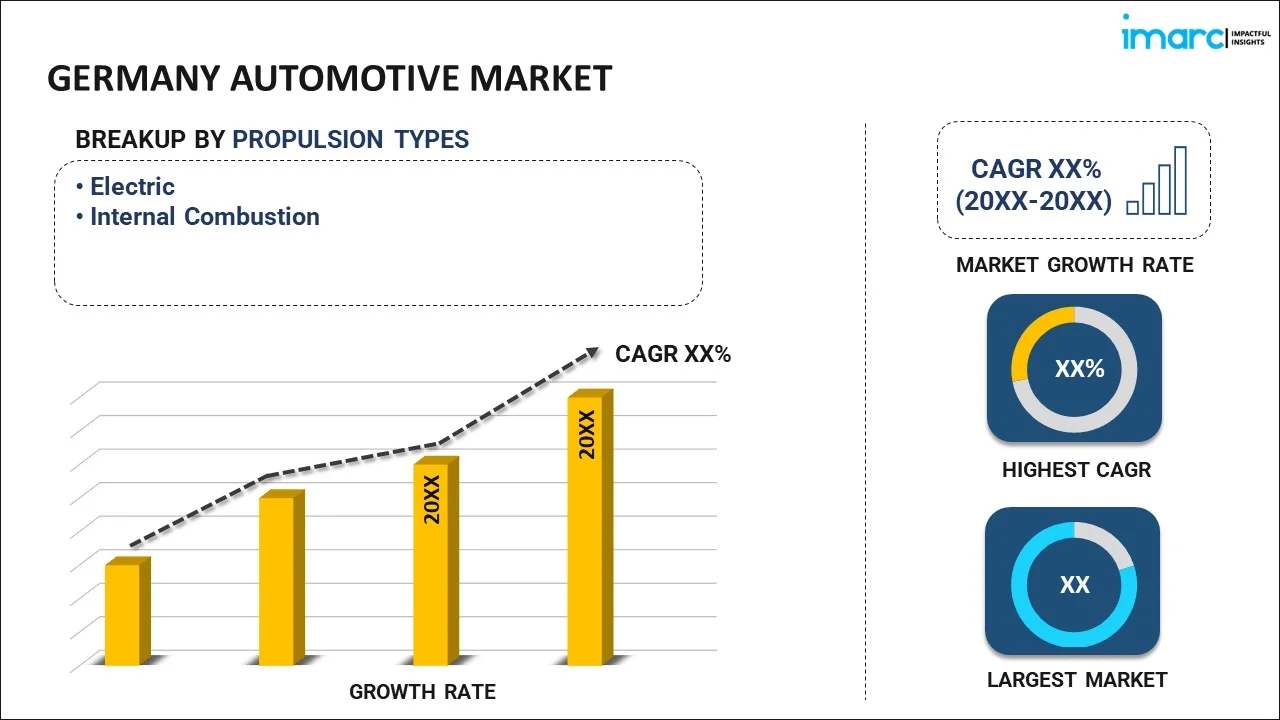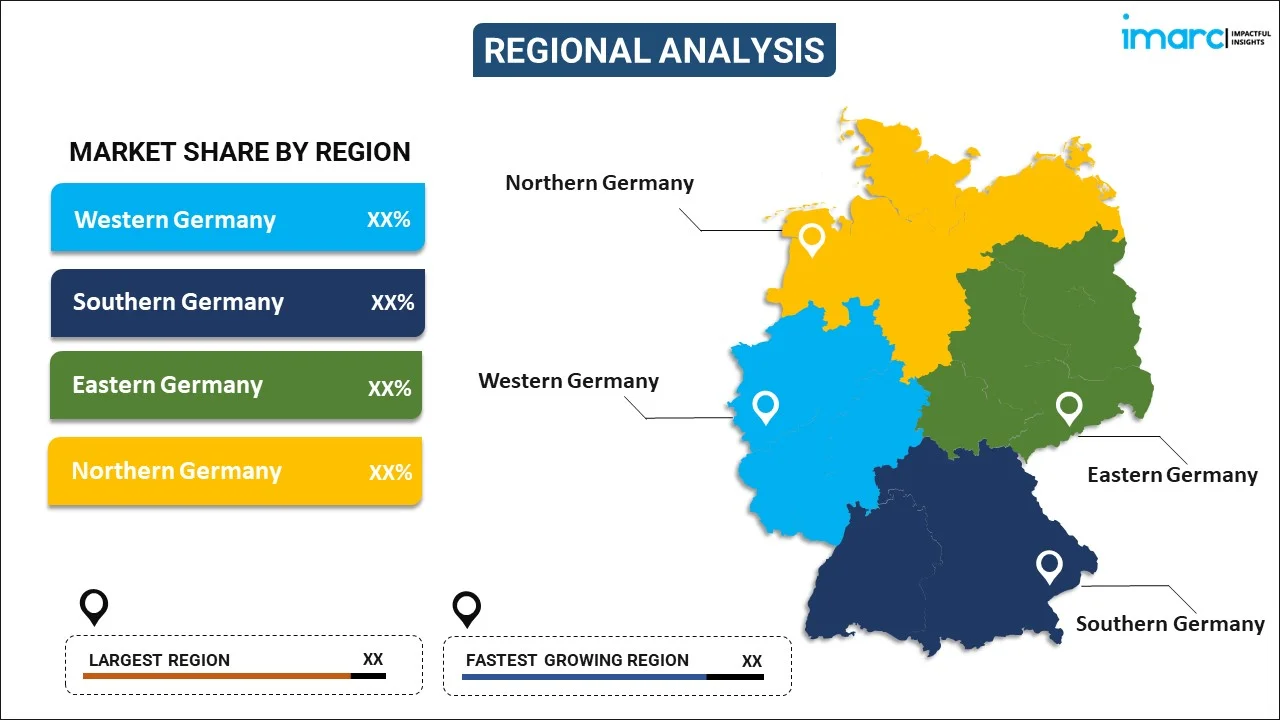
Germany Automotive Market Report by Propulsion Type (Electric, Internal Combustion), Vehicle Type (Commercial Vehicles, Passenger Vehicles), and Region 2025-2033
Germany Automotive Market Overview:
The Germany automotive market size reached 1,443.5 Thousand Units in 2024. Looking forward, IMARC Group expects the market to reach 1,967.3 Thousand Units by 2033, exhibiting a growth rate (CAGR) of 3.5% during 2025-2033. Significant advancements in electric vehicle (EV) technology, increasing consumer demand for connected and autonomous vehicles, government incentives and regulations promoting sustainable transportation, and the rising need for improved fuel efficiency and safety features are some of the drivers contributing to the market growth.
|
Report Attribute
|
Key Statistics
|
|---|---|
|
Base Year
|
2024 |
|
Forecast Years
|
2025-2033
|
|
Historical Years
|
2019-2024
|
| Market Size in 2024 | 1,443.5 Thousand Units |
| Market Forecast in 2033 | 1,967.3 Thousand Units |
| Market Growth Rate (2025-2033) | 3.5% |
Germany Automotive Market Trends:
Shift towards electric vehicles (EVs)
Escalating environmental concerns and stringent regulations to reduce carbon emissions are major drivers of this shift. Global governments are incentivizing EV adoption through tax rebates, subsidies, and grants. In line with this, Germany’s Transport Minister Volker Wissing announced the government's goal of having at least 15 million EVs on German roads by 2030, which is contributing to the market growth. Moreover, significant advancements in battery technology are making EVs more affordable and extending their driving range, enhancing consumer acceptance. Besides this, the expanding range of EV models due to significant automakers' investments in EV research and development (R&D) is aiding in market expansion. Furthermore, the rapid development of EV infrastructure, including charging stations, is also contributing to the acceleration of the shift from internal combustion engine vehicles to electric alternatives.
Development of autonomous driving technology
Autonomous vehicles (AVs) are revolutionizing transportation by enhancing safety, reducing traffic congestion, and providing new mobility solutions. The significant advancements in sensor technology, artificial intelligence (AI), and machine learning (ML) are enabling vehicles to perceive their surroundings and make real-time decisions, bringing the concept of fully autonomous driving closer to reality, thereby strengthening the market growth. Concurrently, new business models like mobility-as-a-service (MaaS) and ride-sharing are being made possible by autonomous driving technology, and these models have the potential to revolutionize urban transportation. Furthermore, the introduction of favorable regulatory frameworks to guarantee the safe deployment of AVs is creating a positive outlook for market expansion.
Integration of advanced connectivity features
Modern vehicles are increasingly being equipped with connected technologies that enhance the driving experience, improve safety, and provide convenience. These features include infotainment systems, telematics, and vehicle-to-everything (V2X) communication, which allows vehicles to interact with each other and with infrastructure. Connectivity enables real-time traffic updates, remote diagnostics, and over-the-air software updates, ensuring that vehicles remain up-to-date with the latest features and improvements. Similarly, the rise of fifth-generation (5G) technology is expected to further enhance vehicle connectivity by providing faster and more reliable communication, enabling advanced applications such as real-time navigation, remote control, and enhanced safety systems, thereby aiding in market expansion.
Germany Automotive Market News:
- In April 2024, Germany and China signed a joint declaration to cooperate on autonomous and connected driving, aiming to develop shared standards and rules for data management. This agreement seeks to ease data transfer restrictions from China to Germany, addressing a key concern for foreign businesses operating in China.
Germany Automotive Market Segmentation:
IMARC Group provides an analysis of the key trends in each segment of the market, along with forecasts at the country level for 2025-2033. Our report has categorized the market based on propulsion type and vehicle type.
Propulsion Type Insights:

- Electric
- Internal Combustion
The report has provided a detailed breakup and analysis of the market based on the propulsion type. This includes electric and internal combustion.
Vehicle Type Insights:
- Commercial Vehicles
- Passenger Vehicles
A detailed breakup and analysis of the market based on the vehicle type have also been provided in the report. This includes commercial vehicles and passenger vehicles.
Regional Insights:

- Western Germany
- Southern Germany
- Eastern Germany
- Northern Germany
The report has also provided a comprehensive analysis of all the major regional markets, which include Western Germany, Southern Germany, Eastern Germany, and Northern Germany.
Competitive Landscape:
The market research report has also provided a comprehensive analysis of the competitive landscape. Competitive analysis such as market structure, key player positioning, top winning strategies, competitive dashboard, and company evaluation quadrant has been covered in the report. Also, detailed profiles of all major companies have been provided.
Germany Automotive Market Report Coverage:
| Report Features | Details |
|---|---|
| Base Year of the Analysis | 2024 |
| Historical Period | 2019-2024 |
| Forecast Period | 2025-2033 |
| Units | Thousand Units |
| Scope of the Report | Exploration of Historical Trends and Market Outlook, Industry Catalysts and Challenges, Segment-Wise Historical and Future Market Assessment:
|
| Propulsion Types Covered | Electric, Internal Combustion |
| Vehicle Types Covered | Commercial Vehicles, Passenger Vehicles |
| Regions Covered | Western Germany, Southern Germany, Eastern Germany, Northern Germany |
| Customization Scope | 10% Free Customization |
| Post-Sale Analyst Support | 10-12 Weeks |
| Delivery Format | PDF and Excel through Email (We can also provide the editable version of the report in PPT/Word format on special request) |
Key Questions Answered in This Report:
- How has the Germany automotive market performed so far and how will it perform in the coming years?
- What has been the impact of COVID-19 on the Germany automotive market?
- What is the breakup of the Germany automotive market on the basis of propulsion type?
- What is the breakup of the Germany automotive market on the basis of vehicle type?
- What are the various stages in the value chain of the Germany automotive market?
- What are the key driving factors and challenges in the Germany automotive?
- What is the structure of the Germany automotive market and who are the key players?
- What is the degree of competition in the Germany automotive market?
Key Benefits for Stakeholders:
- IMARC’s industry report offers a comprehensive quantitative analysis of various market segments, historical and current market trends, market forecasts, and dynamics of the Germany automotive market from 2019-2033.
- The research report provides the latest information on the market drivers, challenges, and opportunities in the Germany automotive market.
- Porter's five forces analysis assist stakeholders in assessing the impact of new entrants, competitive rivalry, supplier power, buyer power, and the threat of substitution. It helps stakeholders to analyze the level of competition within the Germany automotive industry and its attractiveness.
- Competitive landscape allows stakeholders to understand their competitive environment and provides an insight into the current positions of key players in the market.
Need more help?
- Speak to our experienced analysts for insights on the current market scenarios.
- Include additional segments and countries to customize the report as per your requirement.
- Gain an unparalleled competitive advantage in your domain by understanding how to utilize the report and positively impacting your operations and revenue.
- For further assistance, please connect with our analysts.
 Request Customization
Request Customization
 Speak to an Analyst
Speak to an Analyst
 Request Brochure
Request Brochure
 Inquire Before Buying
Inquire Before Buying




.webp)




.webp)












